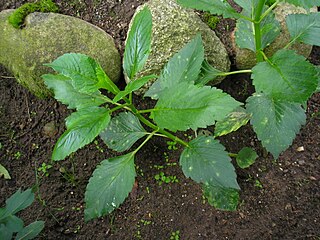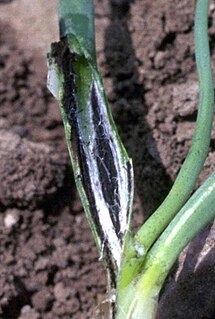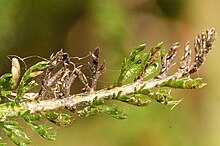
Basidiomycota is one of two large divisions that, together with the Ascomycota, constitute the subkingdom Dikarya within the kingdom Fungi. Members are known as basidiomycetes. More specifically, Basidiomycota includes these groups: mushrooms, puffballs, stinkhorns, bracket fungi, other polypores, jelly fungi, boletes, chanterelles, earth stars, smuts, bunts, rusts, mirror yeasts, and Cryptococcus, the human pathogenic yeast. Basidiomycota are filamentous fungi composed of hyphae and reproduce sexually via the formation of specialized club-shaped end cells called basidia that normally bear external meiospores. These specialized spores are called basidiospores. However, some Basidiomycota are obligate asexual reproducers. Basidiomycota that reproduce asexually can typically be recognized as members of this division by gross similarity to others, by the formation of a distinctive anatomical feature, cell wall components, and definitively by phylogenetic molecular analysis of DNA sequence data.

Heinrich Anton de Bary was a German surgeon, botanist, microbiologist, and mycologist . He is considered a founding father of plant pathology (phytopathology) as well as the founder of modern mycology. His extensive and careful studies of the life history of fungi and contribution to the understanding of algae and higher plants were landmarks of biology.

Ustilago is a genus of approximately 200 smut fungi parasitic on grasses.

Pleurotus eryngii is an edible mushroom native to Mediterranean regions of Europe, the Middle East, and North Africa, but also grown in many parts of Asia.

Ustilaginomycetes is the class of true smut fungi. They are plant parasites with about 1400 recognised species in 70 genera. They have a simple septum with a septal pore cap, this is different from Agaricomycotina which has a dolipore septum with parenthoesome. The group is monophyletic.

The Ustilaginales are an order of fungi within the class Ustilaginomycetes. The order contains 8 families, 49 genera, and 851 species.

Mikhail Stepanovich Voronin was a prominent Russian biologist, a botanist with particular expertise in fungi.

Entyloma dahliae is a species of smut fungus in the family Entylomataceae. It is the causative agent of Dahlia leaf smut. The species was described in 1912 by Hans Sydow and Paul Sydow.

Julius Oscar Brefeld, usually just Oscar Brefeld, was a German botanist and mycologist.

Joseph-Henri Léveillé was a French physician and mycologist who was a native of Crux-la-Ville, in the department of Nièvre.

Sclerotinia is a genus of fungi in the family Sclerotiniaceae. The widely distributed genus contains 14 species.

Urocystis is a genus of smut fungi containing plant pathogens, which infect grass species and other plants.

Pleurotus nebrodensis, commonly known as funcia di basilicu "fungus of Basil" or carduncieddu di macchia "macchia carduncieddu(?)", is a fungus that was declared by the IUCN as critically endangered in 2006. This fungus only grows on limestone in northern Sicily in association with Cachrys ferulacea. The characteristics of the mushroom are its creamy white to yellow colour, its diameter of between 5 and 20 centimeters, its extremely angled gills, and the breaking apart of the cap surface at maturity.

The Ustilaginaceae are a family of smut fungi in the order Ustilaginomycetes. Collectively, the family contains 17 genera and 607 species.
Sphaceloma is a genus of ascomycete fungi. Its species are plant pathogens, and cause anthracnose and scab diseases. The widespread genus is estimated to contain 52 species.
Entylomella is a genus of smut fungi in the family Entylomataceae. The genus, which contains anamorph forms of Entyloma species, was circumscribed in 1924 by Franz Xaver Rudolf von Höhnel.

The Urocystidales are an order of fungi within the class Ustilaginomycetes. The order contains 6 families and about 400 genera. They are a sister order to Ustilaginales.












